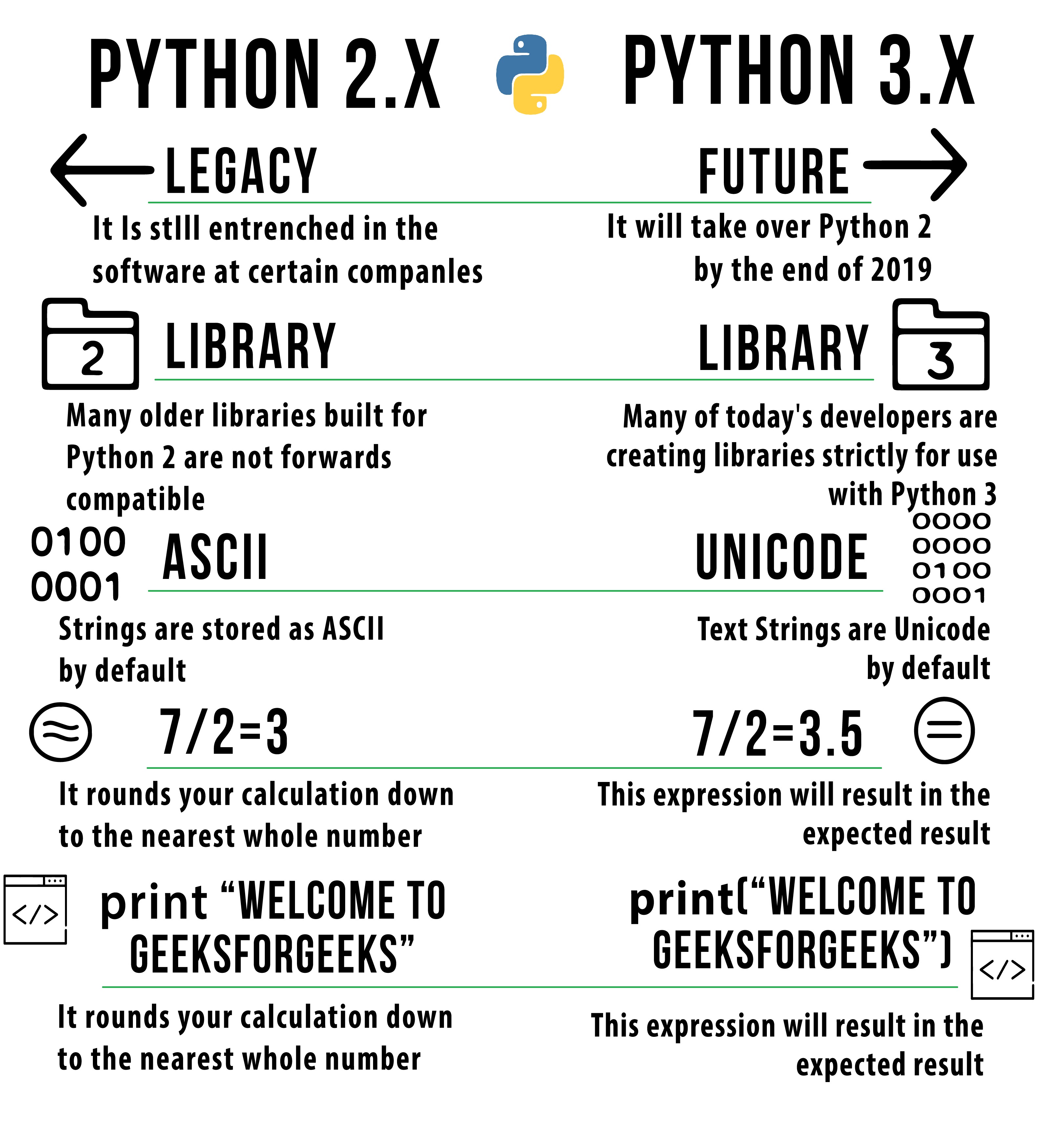Python2 vs Python3 | Syntax and performance Comparison
Last Updated :
28 Oct, 2019
Python 2.x has been the most popular version for over a decade and a half. But now more and more people are switching to Python 3.x. Python3 is a lot better than Python2 and comes with many additional features. Also, Python 2.x is becoming obsolete this year. So, it is now recommended to start using Python 3.x from now-onwards.
Still in dilemma?
Ever wondered what separates both of them? Let’s find this thing out below.
First of all, let us go through this quick comparison through this image, which will give you a fair idea on what to expect.

Print Statement
Python 2.7: Extra pair of parenthesis is not mandatory in this.
print 'Hello and welcome to GeeksForGeeks'
|
Python 3.x: Extra pair of parenthesis is mandatory.
print ('Hello and welcome to GeeksForGeeks')
|
Integer Division
Python 2.7:
The return type of a division (/) operation depends on its operands. If both operands are of type int, floor division is performed and an int is returned. If either operand is a float, a classic division is performed and a float is returned. The // operator is also provided for doing floor division no matter what the operands are.
Python 3.x:
Division (/) always returns a float. To do floor division and get an integer result (discarding any fractional result) you need to use // operator.
print (-5 / 2)
print (5//2)
|
Input Function
Python 2.7:
When you use input() function, Python automatically converts the data type based on your input.
val1 = input("Enter any number: ")
val2 = input("Enter any string: ")
type(val1)
type(val2)
|
raw_input gets the input as text (i.e. the characters that are typed), but it makes no attempt to translate them to anything else; i.e. it always returns a string.
val1 = raw_input("Enter any number: ")
val2 = raw_input("Enter any string: ")
type(val1)
type(val2)
|
Python 3.x
In Python3, the input function acts like raw_input from Python 2.7 and it always returns string type.
val1 = input("Enter any number: ")
val2 = input("Enter any string: ")
type(val1)
type(val2)
|
Round Function
Python 2.7: The output always results in a floating point number.
print(round(69.9))
print(round(69.4))
|
Python 3.x: The return results in n digit precision.
print(round(69.9))
print(round(69.4))
|
List Comprehensions
Python 2.7: Refer to the example below, how global variable changes.
num = 7
print (num)
mylist = [num for num in range(100)]
print (num)
|
Python 3.x: There is no namespace leak now. This is quite fixed now.
num = 7
print (num)
mylist = [num for num in range(100)]
print (num)
|
Range Function
Python 2.7 :
It has both range and xrange function. When you need to iterate one object at a time, use xrange and when you need an actual list, use range function. xrange is generally faster & saves memory.
% timeit [i for i in range(1000)]
% timeit [i for i in xrange(1000)]
|
Python 3.x :
Here range does what xrange does in Python 2.7. xrange doesn’t work in Python 3.x.
% timeit [i for i in range(1000)]
% timeit [i for i in xrange(1000)]
|
Exception Handling
Python 2.7 : This has a different syntax than Python 3.x.
try:
YoYo
except NameError, error:
print error, "YOU HAVE REACHED FOR AN ERROR"
try:
YoYo
except NameError as error:
print error, "YOU HAVE REACHED AN ERROR, YET AGAIN !"
|
Python 3.x: ‘As’ keyword is needed to be included in this.
try:
YoYo
except NameError as error:
print (error, "THE ERROR HAS ARRIVED !")
|
List Comprehensions
Python 2.7: Lesser parenthesis than Python 3.x.
[item for item in 1, 2, 3, 4, 5]
[1, 2, 3, 4, 5]
|
Python 3.x: Extra pair of parenthesis is needed here.
[item for item in (1, 2, 3, 4, 5)]
[1, 2, 3, 4, 5]
|
next() function and .next() method
Python 2.7: Both next() and .next() are used here.
generator = (letter for letter in 'abcdefg')
next(generator)
generator.next()
|
Python 3.x: Only next() is used here. Using .next() shows an AttributeError.
generator = (letter for letter in 'abcdefg')
next(generator)
|
ASCII, Unicode and Byte types
Python 2.7: It has ASCII string type, a separate unicode type, but there is no byte type.
type(unicode('a'))
type(u'a')
type(b'a')
|
Python 3.x: We have unicode strings, and byte type.
Note: List of Methods & Functions that don’t return list anymore in Python 3.x.
In Python2.x -
zip()
map()
filter()
dictionary’s .keys() method
dictionary’s .values() method
dictionary’s .items() method
Like Article
Suggest improvement
Share your thoughts in the comments
Please Login to comment...